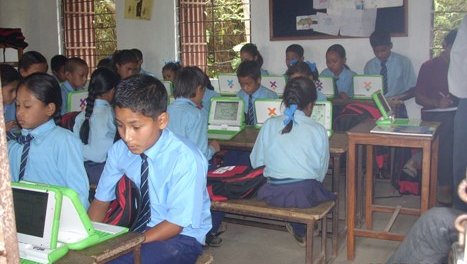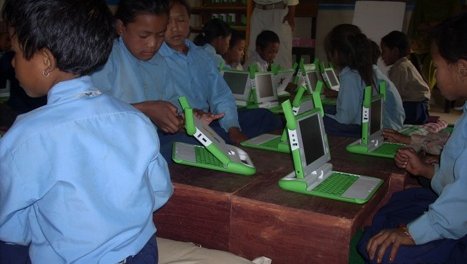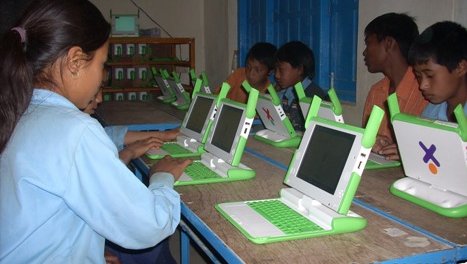We have just completed Part II of our teacher preparation program. The complete teacher training consisted of two segments:
Part I) A 4 day intensive residential, out-of-school training that focuses on integrating digitial educational materials and ICT-based teaching approaches in the regular classroom instruction process. This was completed on April 1, 2008. An earlier blog post has details about this segment of the training.
Part II) A 4 day training in the teachers’ regular classrooms where they get hand-on experience in developing, implementing, and fine-tuning child-centric, interactive, ICT-integrated lesson plans. This was completed on Friday, May 2, 2008. The current post is about this segment only.
Training location
For Bashuki teachers, the training was held at Bashuki Lower Secondary School itself. Similarly, for Bishwamitra teachers, it was held at Bishwamitra Lower Secondary School.
Why in-school training?
Important fact: TEACHING THE KIDS HOW TO USE THE LAPTOPS IS A RELATIVELY EASY TASK. THEY PICK IT UP IN NO TIME (within a few hours!!).
Even more important fact: THE REAL CHALLENGE IS INTEGRATING THE LAPTOP AND THE AVAILABLE DIGITAL CONTENT IN THE REGULAR CLASSROOM INSTRUCTION PROCESS.
The residential portion of the training did give the teachers some experience in integrating E-Paati in the classroom process (apart from making them completely familiar with the use of the laptop). But the simulated classroom environment in any residential training is a far cry from the actual setting in their own schools. Furthermore, since each school is very different in terms of physical infrastructure, student composition, community involvement and other resources, there are unique practical challenges associated with each school. So we felt that it would be very useful to give teachers hands-on experience in integrating E-Paati in their regular classrooms.
There is another important reason why in-school training is important in this case. In most teacher training programs, it is possible for teachers to learn about new approaches to teaching outside their school (for example, through practice teaching in another school) and they can take this knowledge to their own classrooms later. But in the present context, successful implementation in the classroom also requires the students themselves to learn about the new approach to learning and teaching. And this can only happen in the school where the laptop program is being implemented.
Structure of the training
Each day of the training was divided into four major segments:
On the first day of the training (Saturday, April 26), the teachers focused on teaching the students how to use the laptop and the E-Paati activities in the laptop. This was done in two 1.5 hour long sessions.
During the remaining four days, the teachers conducted regular math and English classes in grades two and six according to the ICT-integrated lesson plans they developed. At Bishwamitra the ICT-integrated classes were held on Sunday (April 27) , Monday (April 28), Tuesday (April 29) and Wednesday (April 30). Bashuki conducted similar classes starting Monday (April 29). But since they had decided to keep the laptops in school for this first week of classes, they set aside Wednesday (April 30) for giving students more practice on how to use the laptops. They had a break on Thursday and completed the training program on Friday (May 2).
Overview of content covered in the training
Lesson planning: Integrating ICT-based educational materials in the classroom requires teachers to carefully plan their lessons. We wanted to give the teachers a very simple framework for developing lesson plans so that they would continue to use it even after the training. If they were to use it throughout the year, they would have to see that planning the lessons would not really take up too much of their time—and that it would help them in their other classes as well.
Each lesson plan in this training consisted of the following: a) listing of the learning objectives of the class, b) listing and brief descriptions of the topics or activities to be covered in the class, and c) listing of time allocated for each topic or activity. E-Paati activites were integrated in each lesson plan as one of the many activities covered to meet the learning objectives of the class. We emphasized that the goal should be to integrate E-paati in the classroom lesson plan; not devise a lesson plan around the E-Paati activities. As a rule of thumb, we emphasized that E-Paati use should not take up more than 40% of the total time allocated for the class.
Lesson plan review and revision: The lesson plans developed were critically reviewed and revised by all the teachers together to make sure that a) the learning objectives of lesson were properly clarified, b) the topics covered—including E-Patti topics—were consistent with the stated learning objectives, and c) the time allocated for each topic/activity was appropriate.
Classroom instruction and observation: This segment of the daily training was designed to (i) give subject teachers hands-on experience in teaching according to the integrated lesson plans and (ii) enable other teachers to critically examine the teaching-learning process in the regular classroom. Hence, while the subject teacher was conducting the lesson, the other teachers noted down their critical observations in the following areas:
a) Classroom structure (including appropriateness of seating arrangement, placement of charging racks, seat assignment schemes etc.)
b) Correspondence between lesson plan and practice
c) Time on task (effective use of time from the perspective of student learning)
d) Interaction (student—student; student—teacher) and participation of students in the learning process
e) Instruction delivery (clarity, adequacy of explanations, …)
f) Time and classroom management (including tackling disruptive behavior on the part of students)
Feedback session: Feedback sessions were held at the end of each day to critically review the classroom process. The teachers delivering the lectures worked with the observers to analyze the strengths and weaknesses of the classes held that day focusing on the six areas listed above. Through these discussions, the participants were able to identify areas that needed improvement and develop strategies for tackling problems.


Staff involved in the training
Facilitators/observers:
Most interesting outcomes



Our main “mantras” for the training